Shriner’s Hospital Returns To St. Louis City After 52 Years In Suburban Frontenac
Sunday afternoon the new Shriner’s Hospital for Children will be dedicated. The new facility will open for patients on June 1st, a return to the City of St. Louis after 52 years in the affluent suburb of Frontenac.
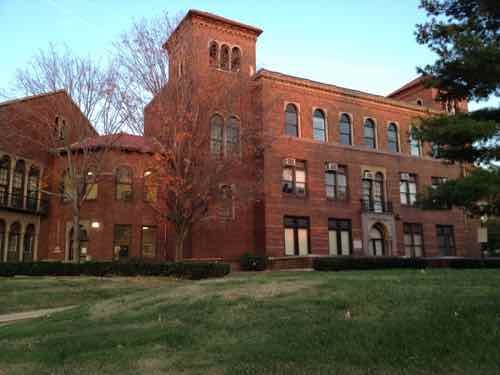
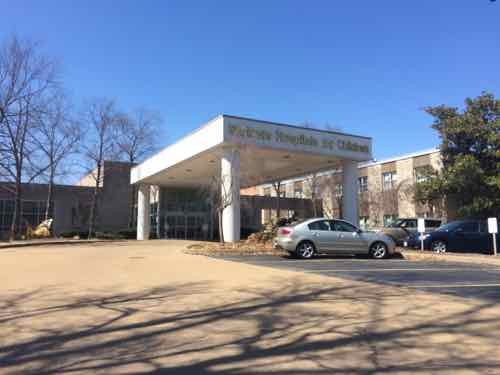
Changes in care meant the 1960s facility was too large:
The hospital is leaving a 182,000-square-foot facility in Frontenac for a 90,000-square-foot facility in St. Louis. The new hospital, at 4400 Clayton Avenue, will continue to use 12 inpatient beds despite its license for 80. (Post-Dispatch)
Many of us have been watching the new building take shape for a while now, much more visible than the facility they’re leaving.
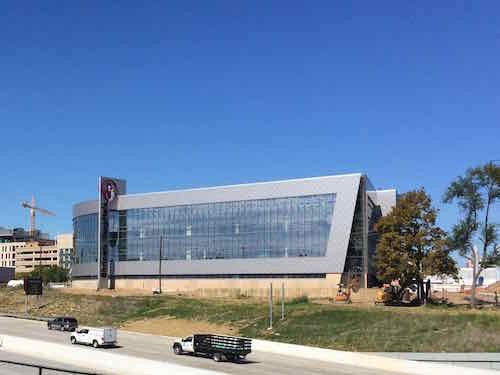
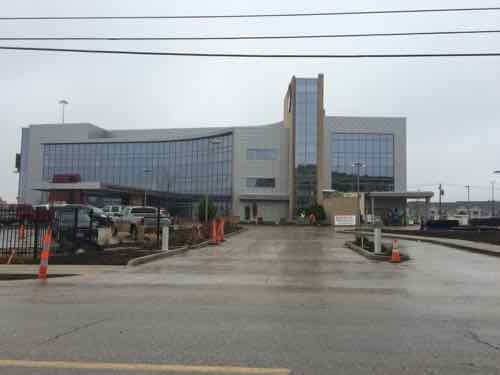
About Sunday’s dedication:
New hospital dedication ceremony May 17
Dedication of the new replacement hospital for Shriners Hospitals for Children — St. Louis, will take place from 1 – 4 p.m., Sunday, May 17.Imperial Potentate Dale Stauss and Chairman of the Board of Trustees Doug Maxwell will officially open the building for visitors that day. Following a special ceremony featuring the local and national leadership of Shriners Hospitals for Children – as well as a few surprises from the patients – the hospital will be open for tours. Tours of the hospital will include a once-in-a-lifetime opportunity to see in some areas of the hospital that will be restricted to patients, families and employees only, such as the operating rooms, patient rooms and patient-family quarters.
Sunday’s dedication is open to the public. Yesterday I got a tour of the facility, here are most of the photos I took:
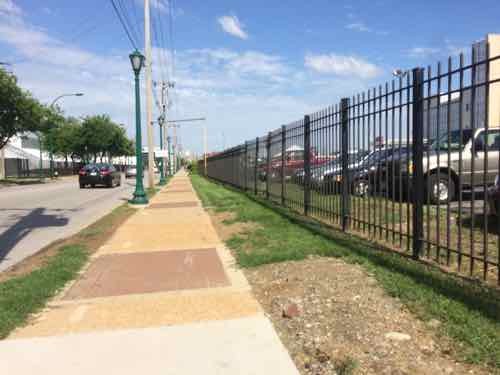
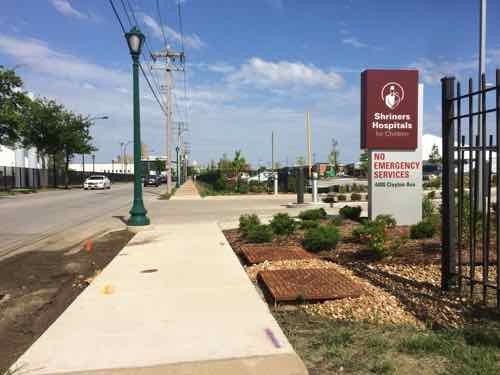
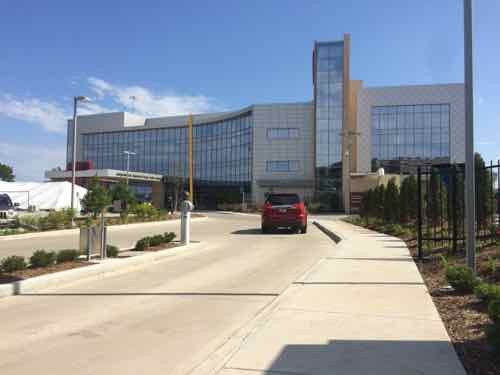
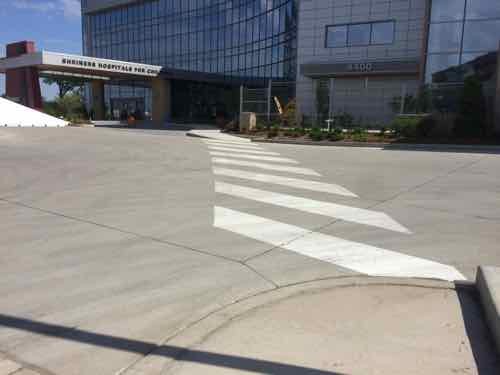
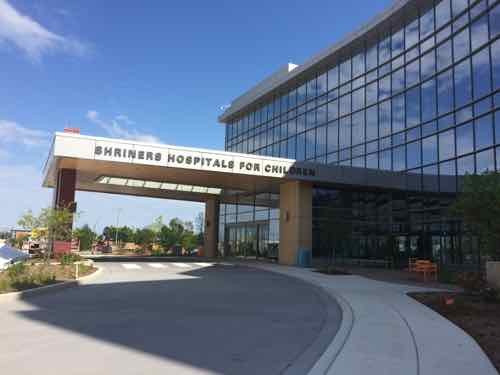

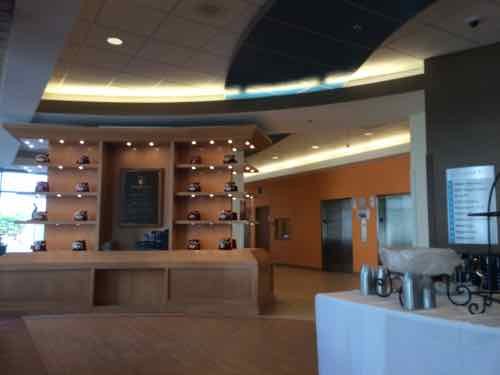
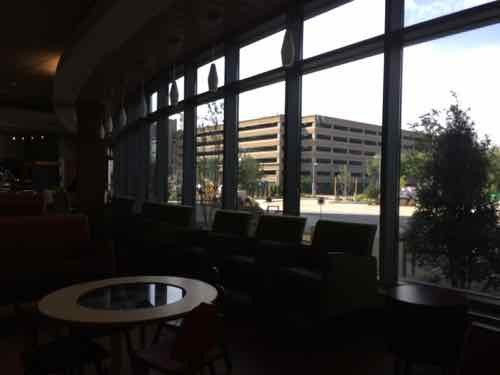

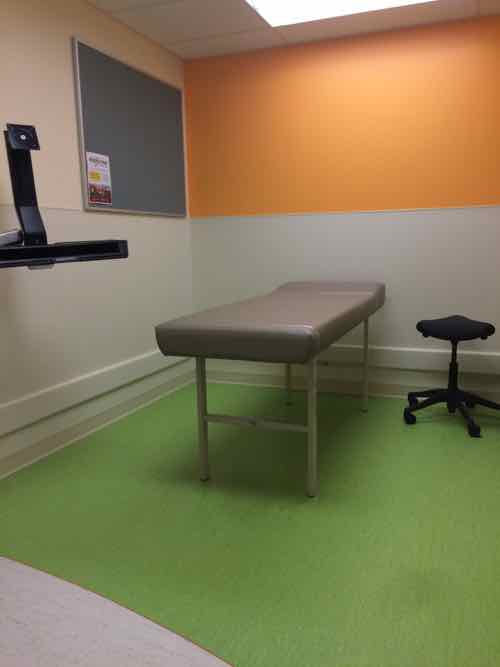
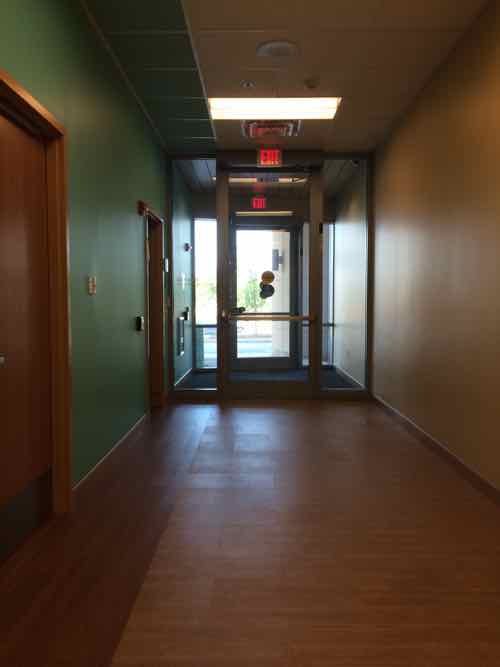
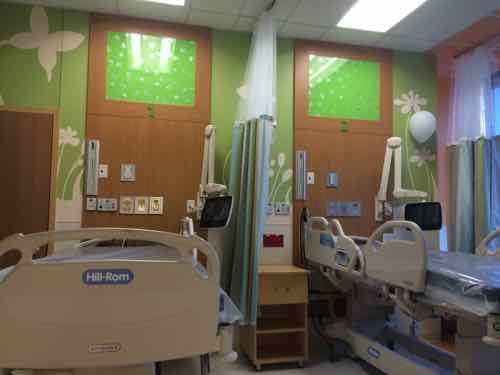
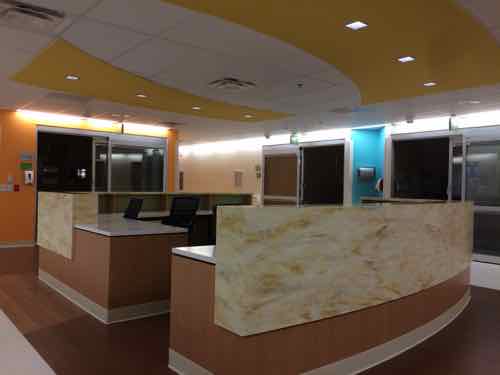
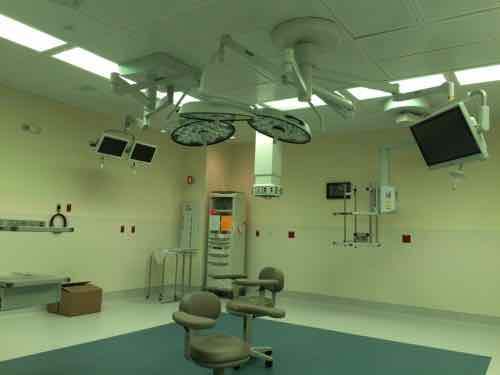
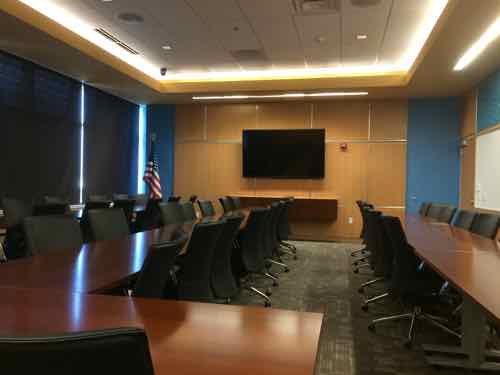
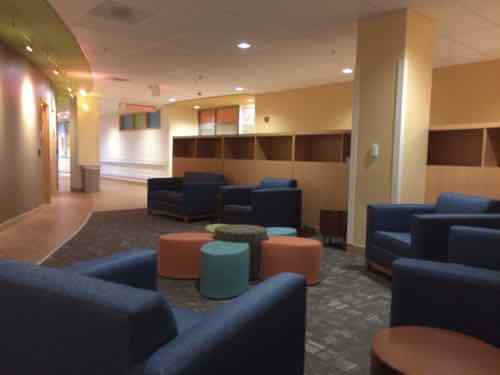
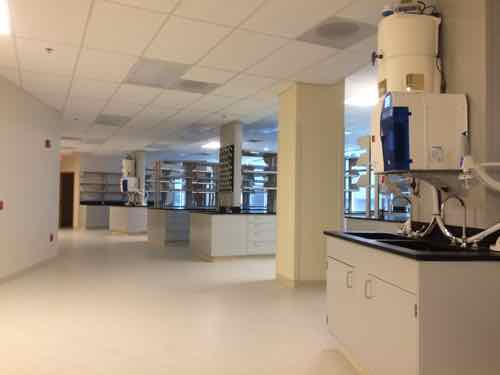
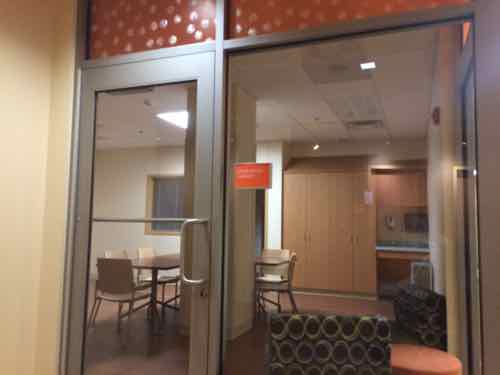
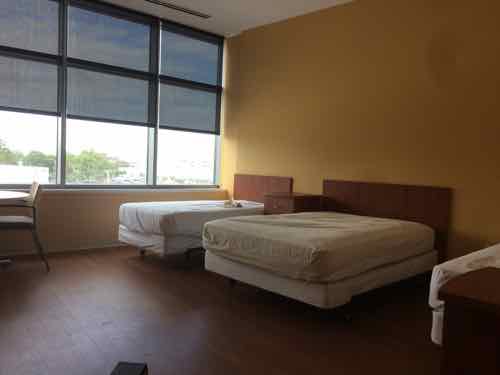
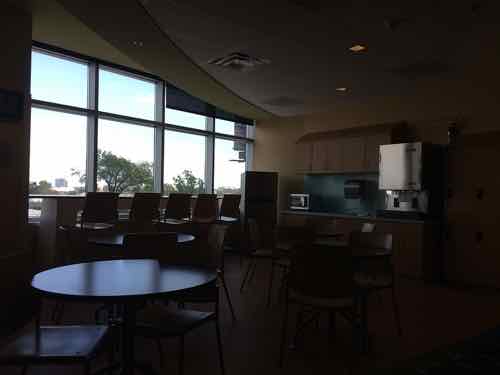
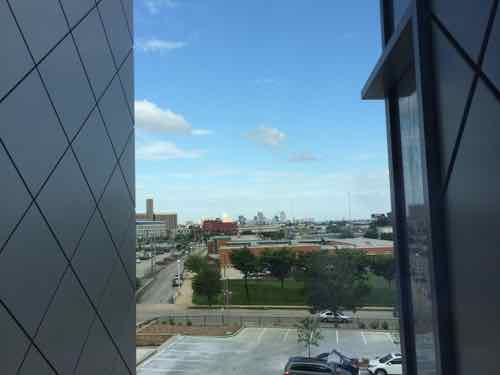
This new hospital is good news for the City of St. Louis, even better news for the young patients & their families who’ll receive care here in the decades to come. I know the hospital where I had surgery at age 4 looked nothing like this, it was a scary institutional place. Thankfully all new hospitals have gotten more welcoming.
The last all-new hospital in the 22-hospital Shriner system was in 1997 — so this is a big deal. Shriner’s St. Louis has always had a connection to Washington University, this new location will strengthen that relationship. Again, Sunday’s dedication is open to the public.
Welcome back Shriners!
— Steve Patterson
It looks to be a nicely done building, the
beef I have is what Camilo Sitte called “wedding cake architecture”,
a building stuck into the middle of a lot. Of course a hospital will have good
ADA access, but from your photos and my own observations of the site numerous
times, you have to ask if they tried could they have made the approach more
inhuman than what you show in your photographs? For one thing, it is as if the
pedestrian parked a car in the most distant part the parking lot and walked.
The pedestrian should have premium access, or at least not treated as so
insignificant and second class that their access to the building is equal to
the worse parking spot on the lot.
I mean yea there is a walkway to the building, but the dominance of the auto in
aesthetics and site planning is readily apparent. The attitude is that the pedestrian
is meaningless. This particular area is one that could be walkable with a
little effort, although the new building up the street at Clayton and Taylor
appears as if it too will ignore the pedestrian and by extension, transit in
its site plan.
City officials are woefully handling the urban planning in this area (and the
rest of the city for that matter) There is a lack of consistency and with the
existing density surrounding this site, transit approaches would complement the
pedestrian activity nicely, balanced with the auto.
Instead the area along Clayton Av is being pushed towards an auto only
approach. This is an urban planning choice, either that or it’s ignorance. It
has to be one or the other.
While the new Shriner Building appears successful, the site planning only
exacerbates the poor condition of the St Louis environment for living beings to
use and enjoy if they are not in a car.
As if ailing children are walking to the hospital.
Are you just miserable all of the time? You seem to bitch about everything in this city.
Huh? I’m pleased they realized staff, volunteers, family, & visitors may be pedestrians.
What’s mistadme is ignorant commenrs like youra.
Last year their patients came from 35 U.S. States, as well as several foreign countries — it would be foolish to expect the family of these patients to all drive cars to this facility. It’s notated a short walk from thr busiest MetroLink station in Metro’s system and a BJC/WU shuttle stops right outside the facility.
It would also be foolish not to expect most patients to arrive by private vehicles, especially for extended stays. Few people* use public transit where they live; even fewer use it when they travel. *2.3%, per this weekend’s article in the Post-Dispatch, which translates into 97.7% NOT using transit for their daily commutes!
It is also foolish to expect people to use transit if pedestrians and transit users are treated as 2nd or 3rd class class citizens as is the case with most new development in St Louis. As I said this is especially a missed opportunity at this site because of the already existing density, including housing and the fact many surrounding areas are already walkable, making it possible to connect various neighborhoods.
Instead, with the Shriners and the new building on Taylor, it seems yet another street has been handed over to auto centric development.
The real irony is that is would not have cost any more to do a creative site plan that served pedestrians, transit and autos equally well.
Could the site have been designed differently, “better”? Absolutely! But given its location, its move from non-pedestrian-friendly, non-transit-friendly Frontenac to a highly-walkable, transit-served, medical complex, you’re finding “problems” where few actually exist. The Shriners have a much better idea about what their patients, their families and their employees need and want than you do, and the Shriners are the ones that wrote the big check to make this happen, in exactly this form, in this much better location. If you don’t agree, join the Shriners, get on their board, make changes from the inside – don’t expect the city to dictate to every land owner exactly how they must use their property – THAT will do more to drive business from the city than anything else!
What is telling is that you could take this entire Shriner site and set it down in Chesterfield and no one would notice the difference. It is auto centric and does not reflect its location in an urban area.
What it really points to is a city that does not support consistent urban development with policies to back them up.
In thinking about this site, basically the area between Clayton Av and Forest Park Expressway have a pedestrian and transit friendly neighborhoods to the north and to the site of this area.
Right now the buildings in the Shriner neighborhood are mixed and inconsistent in their approach to pedestrians and transit. Transit is pretty good in this area, but the pedestrian support is not.
In general this is a failure by city government in not guiding development in a way that is coherent for all potential users, not just autos, it is the difference between St. Louis and Chesterfield, where you find little or no transit.
There are many neighborhoods in St. Louis that are transitional like this. The failure of city policy to develop coherent approaches and policies is harming the city and damages the city economically
A coherent approach will encourage development and investment, not drive it away, the automobiles don’t care where they park, but a pedestrian friendly environment, or the lack of it, is obvious. BJC and every business in the area would benefit from a viable and vital pedestrian environment.
It is patently ridiculous to suggest I join the Shriner board. Creating a livable city for all residents is a broad problem. No one is any one is going to be chased away by building a more inclusive city that includes pedestrian concerns.
I am not familiar with the investment of Shriners, the city typically kicks in considerable amounts of public money for most of these large projects.
No, what I’m saying is the difference between a glass half full or a glass half empty. Too many times, on this blog, people want to tear apart every weak point on every project, instead of celebrating the many, small, incremental steps, in the right direction. The Shriners’ hospital is a regional destination, one that caters to people with severe physical limitations, from a very large area. Yes, if we made it more pedestrian and transit “friendly”, yes, maybe a few more patients would choose one (or both) of those options. However, the vast, vast majority of the “unenlightened” masses from 2, 12 or 33 counties away ARE GOING TO CONTINUE TO DRIVE! Making parking and driving “harder” may fit your urban paradigm, but it would truly suck for the vast majority of the patients USING this facility. If you want continued investment in the city, it needs to fit how we choose to live in the 21st century, not how our ancestors chose to live in theirs!
Unfortunately we are likely to end up in the stone age again if we continue our wanton ways.
Plus you are missing the point about a city government that helps facilitate solutions which enhance the lives of all inhabit the city and the larger region, not just those who drive an automobile.
You talk as if we choose this way to live in the 21st century. Do you really believe auto centric development is the pinnacle of society? Do you really believe there are choices between the auto, transit, bicycle and pedestrian activity that are presented as viable and real choices, so a true free market is even present?
There are no real choices, and in cities where the transit, pedestrian situation is equal to the automobile, transit and pedestrians prevail and help create a desirable city.
Actually our forefathers were closer to building sustainable and attractive cities for all residents compared to anything that is going on today.
The underlying problem is that if the City of St. Louis cannot get it together with some sort of rational balance of movement systems. It is likely St. Louis is doomed to be an under performing region that is fundamentally undesirable for business and living.
All the winning Cardinal teams in the world are not going to overcome those faults.
Soooo . . . would this make you happy? http://nextcity.org/features/view/kansas-city-mall-downtown-development-subsidies-cordish-companies?utm_source=SFFB
The link is meaningless to the discussion, What’s your point?
The “point” is that most private property owners have a pretty good idea about how they need to run their businesses and that “government” is usually pretty inept when it tries compete in the private sector. I’ll repeat, the Shriners’ Hospital is a REGIONAL destination, the vast majority of their patients, the patients’ families AND the employees CHOOSE to drive to the location, park their vehicles close to the hospital AND strongly prefer to use the nearest doors to enter and leave the facility. They have little desire to walk a block or two to “enjoy” some abstract, “better” pedestrian “experience”, they’re focused on receiving and delivering high quality medical services in a specialized facility.
I agree that there are “better solutions”. There are also plenty of “worse solutions”, as well. You want to focus on how we’ve missed some abstract level of”perfection”. I want to focus on positive steps. Yes, the Shriners could have moved to Chesterfield; they chose to move (back) to the CWE. What they built is denser than what was there previously. They’re bringing people, jobs and tax revenues back into the city. They’re not evil, they’re good, good for their patients, good for their employees and good for the city. And they, alone, are not going to “move the needle” on “some sort of rational balance of movement systems”, but their presence, their ability to bring more people into the neighborhood, into the city, to increase density, WILL start to create the critical mass needed to make a good/better public transportation system a more viable possibility!
Getting to private property would be impossible if not for the Public Right-of-Way (PROW), it’s government’s function to determine how the PROW looks & functions — which means regulating its borders/walls.
What we should be looking for is not “incremental solutions” as you suggest. Instead we need a basis and foundation for development moving ahead. The one, just one, policy change that could make a huge difference is for the city to simply say we will not approve buildings nor contribute public funds if there is not some effort to recognize the role of the pedestrian and transit (along with the bicycle) in the urban environment. All three entities should be designed for in some fashion at almost every location in St Louis.
I can point to the new CVS along Lindell to illustrate the functionally of the building, nor the use of the automobile is impaired by including pedestrian considerations.
The City of St. Louis does not differentiate itself from suburban environments like Chesterfield. The City is not using its strengths as an urban environment in any way.
Thus you have a building like Shriners, it appears the building itself is well done, but the site plan, the relation to the surrounding city fails miserably.
They at least put a sidewalk in, which is a plus, but when pedestrians are regulated to a discriminatory status and the building is only accessible as if someone in an auto parked in the most remote spot possible to approach the building then, as I say the building could easily be set down in Chesterfield and its auto centric design would not be noticed. The Shriners building does not reflect the City environment it sets in.
You say the Shriners should know what they want, yes that’s true. By the same token you understand any building has to meet regulations that protect the interests of society.
This is true also with the pedestrian/building relationship.
The financial investment of transit should be protected
It is an equality issue giving everyone the same access to public spaces.
There are issues such as climate change and scarce resources the American culture faces and needs to act upon now, not incrementally.
There is much more, but the bottom line is that the Shriners building would have functioned just fine for autos and as a health facility whether or not the site plan reflected a stronger concern for pedestrian traffic.
The idea that it is some big sacrifice for developers and end users to include the pedestrian in design considerations is pure bunk.
In fact transit and pedestrian activity is an economic plus in other cities. St. Louis falls further and further behind.
I have no idea what you’ve been smoking, but I fail to see how pedestrians are “being discriminated against” when there is a) an ADA-compliant path of travel, b) the project is located in a far-more-walkable area than Frontenac, and c) several public transit routes are located nearby. Yes, the building “could” have been constructed up against the public sidewalk, on either Clayton or Newstead (or both), much like how it is currently constructed up against the I-64 right of way, but that would NOT guarantee that a pedestrian entrance would either be provided or maintained on that/those side(s)! Most public facilities, especially a hospital, will have one primary entrance, as shown in photos 4, 7, 8 & 9, primarily for security reasons. The ADA requires a covered drop-off area, so that would logically be at the primary entrance. And when most of your patients / clients are DRIVING to facility, it would also be logical to orient the primary entrance toward the parking that they would be expected to be using.
You continue to espouse this notion that motorists can be coerced into driving less if hostile design solutions are imposed on them through governmental edicts. Making the majority of the patients walk around the building, instead of going directly in, penalizing them, just so a small minority receives slightly better access, that better meets “their” unique needs, ignores the reality of working with most clients. Most clients expect designers to prioritize design choices to serve the majority of their users, as efficiently as possible. And when transit is provided, and 80%, still choose to drive, guess what? Satisfying the drivers’ needs is the bigger priority, in spite of any social engineering agenda you may want to impose! So yes, the new hospital does make “some effort to recognize the role of the pedestrian and transit (along with the bicycle) [plays] in the urban environment.” Their roles are secondary, and the design choices reflect this hierarchy!
Surely you realize the name of this blog is Urban Review. It is designed for a discussion about urban affairs. In fact there are many classes of people that could use the pedestrian access, including workers, visitors and even children whose parents do not have a car.
And yes the political leadership needs to be called out. St Louis has lost more population as a percentage over the last 5 or 6 decades than any other city on the globe. So clearly something is being handled incorrectly. One factor for the decline among many is the failure to include pedestrian and transit concerns into planning decisions.
I understand with your pea sized brain you have trouble making intelligent and civil comments. You are a troll of the worse type, flinging unprovoked insults from the safety of your computer.
The truth is Fozzie you are nothing more than a sick, ignorant and obnoxious twit and a**hole.
I think in part IKEA and Shriner’s put the buildings to the back of the property line was by choice to take advantage of the highway visibility.
I understand that, although in both cases I feel like there are other opportunities to configure the sites to speak to the highway, make them useful for the auto, without leaving pedestrians and transit out of the picture and treating them as second class citizens.
In any case it is clear pedestrians and transit are not priorities and I believe in the long run it is not only harming citizens, but the businesses also. Should St. Louis become another auto centric Chesterfield? That is what public policy seems to be saying.
Sure. The public policy at least at this point in time is that new buildings in this Cortex/BJC area (Shriners and IKEA are both in the Cortex zone, btw) won’t be required to have an expressly more urban site design. Midtown Station will probably be even worse.
Somewhat related, I do look forward to seeing what the GRG trail will look like that will be built as part of the Boyle Metrolink station…. I believe it will run along Clayton in front of Shriners.
The Cortex area is a similar transition area just like what surrounds the Shriners. Ikea is a sophisticated corporation that I assume understands that if there is a transit, pedestrian infrastructure supporting your business that it is a better situation for the business economically.
The St. Louis the urban environment is in disarray and may have been a factor in discouraging Ikea up to this point and likely discourages other companies. This is what city officials and some commentators on this site don’t seem to recognize is that a dysfunctional urban environment actually discourages investment.
Glad to hear the GRG trail is part of the Boyle Metrolink, that is the type creative thinking that is needed. If it runs along Clayton it is one more reason for the Shriner site plan to reflect different values than it does.
It is not up to the Shriner Board to know this but rather city officials should be taking the lead in urban planning and informing Shriners of the visions and possibilities of future projections concerning pedestrian, transit, bicycles, as well as cars. It is the opportunity for the City to differentiate itself from Chesterfield, instead Chesterfield style (crap) is built.
The GRG trail is yet another missed opportunity on the part of city government to create unified visions of what is possible.
I would rather have failure in the attempt to create something better than sit back and accept auto centric developments over and over as the standard
There is a reason St. Louis has lost most of its population over the past 6 decades, If you examine and analyze the decision making mentioned surrounding Cortex and Shriners there is a clear glimpse of the problem and its extent.
City officials must feel very inadequate if the cannot man or woman up and tell potential developers this is what we are trying to achieve. Either that or city officials aren’t really trying to achieve anything, it’s just another day collecting a paycheck. Maybe that’s the problem, they don’t care.
And when was the last time that you were directly involved in the public process for any project in the city? And not just throwing verbal hand grenades? You seem to take great delight in pointing out everyone else’s failures, after the fact, when stuff is actually (being) constructed / “set in stone”. I’ve been involved in multiple processes (and projects) over the years, and my “valuable” input was ignored, more often than not, but at least I was there, early on, when citizen input can change things. Respect is a two-way street, and continually belittling everyone who is even remotely associated with city government undercts what little credibility that you might “bring to the table” . . . . And what IKEA “understands” is that the vast majority of their customers will be driving, no different than Walmart, Target or Costco. Pedestrians and transit users get “treated like second class citizens” because their contribution to the location’s bottom line, the store’s net profit, is MINISCULE! Someone buying a flatscreen or a bookcase won’t be taking it home on the bus. They may be using a car share vehicle, but that needs to be paked, just like a suburban SUV!
I have been involved in the public process extensively in the streets. Writing on this blog and other venues is one way I currently stay involved. So what of it? You want my resume, is that it?
So what do you want to do build a city that only takes action if Target or Costco make a net profit?
The point is, its not like it is a big deal to enact a policy of development that support pedestrians.
The opposite means that unless there is “net profit” for Target or Costco we should not build and higher quality, inclusive city.
In fact look closely at the word inclusive closely. There is no doubt the lack of inclusiveness impacts society leading to problems we face today.
City government deserves to be belittled, we need a revolution, not a half measures as advocated by you and city officials.
(Just look everyone, including pedestrians into design decisions is a revolution)
One example today I saw Recorder of Deeds Sharon Carpenter needs a 700 buck a month car to go along with her 100 grand salary at 40 grand pension. The people of St. Louis have to buy a person a car that does not even go in the field.
So the vast corruption of city government, yes deserves to be belittled.
Government at all levels is not working for the people. Check out the muni court scandal if you want more proof, or the hilarious state legislature For God sakes, and then you act as if I am wrong to criticize the obvious poor management, or basically the management of government for self interest and their friends.
Yeah so everyone is driving. What your message is then is everyone sit on your ass and do nothing to improve the environment.
If you want to have a battle of the resumes, we can go down that road, but that will do little to solve the pedestrian issues that you see as critical to the city’s future success. As you allude to, it’s going to take changing government to make much happen. Where we differ is in how to effect that change. You apparently think the only solution is “revolution”, while I favor evolutionary change. I’d argue that “my” way, at least as in how it’s worked in Denver, is the better path: http://www.denverpost.com/opinion/ci_28123582/dubroff-and-huggins:-drawing-on-experience . . Denver has institutionalized citizen participation and minimized the power of any one politician. It didn’t happen through revolution or casting aspersions, it happened from hundreds of hours of volunteer work on multiple mundane-yet-important issues and building consensus, at the grass-roots level. And it’s been helped, tremendously, by a strong local economy – physical change takes $$$$, and “amenities” are an easier “sell” if there is a common goal (a strong city and a strong region, not every ward and every man for themselves!).
The most basic change to city policy would be a refusal to approve building permits or public money if the project does not consider pedestrian, transit and bicycle concerns.
This would not require any loss of functionality to the end user nor any loss of automobile convenience.
The only thing that really changes is that pedestrians, and by extension transit and bikes, are elevated to the same level as the auto. Notice please the word same.
The real difference between me and you is that you advocate the status quo, of accepting the processes and trying to work with them. It is almost as if you are a spy from Denver who sees St. Louis as potential competition, so you do everything you can to undermine any positive conversations.
When you link to a Denver site that touts sustainability but at the same time doing everything in your power to discredit the same thing for St. Louis, it has to make a person wonder.
But yes, evolutionary is what St. Louis has being doing for decades. It is a dead end. The problem is that if the city is given over too much to autocentric development, it may never recover, (i’m sure the Koch Bros will be overjoyed).
A perfect example is Shriners of course, but even more extreme is the new Ikea. A person taking transit, is yes, discriminated against, and from the corner of Forest Park Expressway and Vandeventer, has to take this unappealing walk. a long distance across a parking lot, further than anyone in an auto would consider walking. Not to mention the aesthetic experience is like zero.
You mention frequency of stops as something that hurts transit, yes that is true, but it is also just as important to recognize the aesthetic nature of travel which requires more than massive amounts of pavement greeting every pedestrian interaction.
I could go on, the new Starbucks on Grand near Tower Grove Park exhibits a balance between pedestrian and auto and includes an outside seating area along Grand.
The economic possibilities are enhanced for Starbucks.
Good urban planning will create economic opportunities and make St. Louis more successful. Your waiting for evolution to occur is what St.Louis has been doing, nothing is happening except the continual decline of St. Louis.
Maybe its time to try something different. You think?
By definition, ANYONE arriving from offsite will have to transition from the perimeter of the site to the front door – it doesn’t matter if you’re on foot, on a skateboard, on a bicycle, in a car, on a bus, in a train or in a helicopter – your trip will require covering the distance between your origin and your destination. If you drive, it will be easier than most other modes (which is why most people make that choice), but the total
distance remains essentially the same. Yes, it would be easier, for both clients and employees, if Metro had a bus that stopped right at the front door (here, and at every other destination), but most riders would have serious objections to stopping every 100′ or 200′ for that level of convenience!
As for “trying something different”, sure, why not? But let’s try a few test cases and see how well reality matches expectations. Shriners is essentially a “done deal” – what we see is what we’re going to get – yet the larger medical campus / Cortex campus is ripe for that sort of discussion. But this is a discussion that needs to be both open and ongoing, not just one between the institutions and a few people in city government.
Finally, every project already “consider[s] pedestrian, transit and bicycle concerns”. They may not prioritize them, but they do “consider” them. Unfortunately, they’re usually quickly dismissed or minimized . . . .
I’m a car slave who loves Denver!
Show me something like this, here, and we can talk: http://www.citylab.com/cityfixer/2015/05/car-free-commuting-just-got-a-whole-lot-easier-in-dc/393875/?utm_source=SFFB . . People drive because it’s the best (and usually only) option that they have. Walking (as transportation) and transit require density, and density has been declining in the city for 3/4 of a century. Sprawl may suck, but it is the reality of our region and our time – same population, four times the area covered – whether it’s IKEA or the Shriners, these destinations need to cater to the desires of their customers to succeed. Until St. Charles County reverts to a population of less than 20,000, parking lots and freeways are going to remain a fact of life. We may not like them, we may want them to go away, but if people are driving, out of choice or necessity, businesses and institutions will continue to provide parking!
Denver’s regional transit usage is nearly twice that of the St. Louis region, so maybe they’re doing something right/better (and we can learn a thing or two): http://fivethirtyeight.com/datalab/how-your-citys-public-transit-stacks-up/ . . And then there’s this: http://fivethirtyeight.com/features/how-suburban-are-big-american-cities/?utm_source=SFFB . . and this: http://www.citylab.com/housing/2015/05/america-has-half-as-many-hypersegregated-metros-as-it-did-in-1970/393743/?utm_source=SFFB . . As long as St. Louis remains insular and unwilling to look at what works elsewhere, St. Louis is going to be stuck with all the negatives of a dying, rust belt city.
St louis is nothing like denver, its built in a completely different way, and it is Much Denser than denver.
Yes, St. Louis city is denser (as well as as geographically smaller), which should make it easier for people to use alternative modes of transportation, yet most choose not to – why?!
Denver population density: 3,992.6 people / square mile (600,158 / 153.0)
St. Louis population density: 5,157.5 people / square mile (319,294 / 61.9)
http://www.governing.com/gov-data/population-density-land-area-cities-map.html
Population-wise, the two Standard Metropolitan Statistical Areas are nearly identical with Denver at 2,754,258 and St. Louis at 2,806,207.
And when it comes to cycling, Denver comes in at 2.9%, while St. Louis comes in at 1.2%: http://bikeleague.org/commutingdata
No balcks on public transt there, scares the white people here, same as Minnie
Yes, higher urban densities and higher public transit use go together – http://fivethirtyeight.com/datalab/how-your-citys-public-transit-stacks-up/ . – and, yes, “St. Louis has lost most of its population over the past 6 decades”, so, yes, for transit to work better in St. Louis, St. Louis needs to get denser, to get more “urban”. The question is HOW to make this happen?! You seem to think that all we need to do is “tell” developers that they need to do denser, more urban developments. Guess what? That ain’t gonna happen! Density happens when there’s an economic reason to spend more money to build more densely (because building more densely DOES cost more money), period, NOT because some government “tells” someone that they “have” to! If it doesn’t make economic sense, the private sector will just do NOTHING! (And that is what is happening, far too often, in the city!)
If anyone else wants to comment here and complain that this building is “too auto centric” I challenge you to go down there when its operational and see what their patients are dealing with along with all their medical devices in tow and tell me they should have made it more “pedestrian” friendly. What’s next, do you want to take away handicapped parking too? People that complain about special needs children having a too auto centric hospital are absolutley disgusting
First, it’s disabled parking — not handicap parking (Americans with Disabilities Act, not Americas with Handicaps Act). Second, the design matters because a better walking environment will produce a healthier community.
Patients will come/go via the side entry I pointed out — likely in a van driven by a volunteer Shriner. But many more people will come/go here on a daily basis.
Then why do the signs say handicap parking? You have no idea of what the parents of these kids are going thru, if we can give them close parking then so be it. They are mentally drained. I used to have a lot of respect for you, not anymore.
Some signs say that, most no longer do.
“2. Never use the term “handicapped parking.” Use “accessible parking” instead.
Handicapped parking is still in use (e.g., when referring to parking placards), though the word “handicapped” is offensive and has been virtually eliminated in most other contexts. Remove it from your organization’s vocabulary completely by using the term “accessible parking.” (It’s also more accurate, as accessible describes the parking and handicapped does not.)”
http://www.diversityinc.com/things-not-to-say/diversity-leaders-6-things-never-to-say-about-disabilities/
I never respected you, amd still dont
It’s a wanton waste of resources not to design, especially in St. Louis City, for the pedestrian and transit considerations that are necessary for vibrant communities.
You want to know why people don’t ride transit? Transit stops and those walking are second class citizens. Most of the transit riders in St. Louis are poor. This is unlike other cities, like say Chicago, that people from all walks of life use transit. There are other factors that contribute to an undesirable transit system, but a pedestrian friendly environment is essential in making transit desirable.
Shriners and Ikea both have cars zoom past while a pedestrian walks as if parking in the furthest parking space on the lot. It is a segregated St. Louis as transit ridership indicates. This inconsistency degrades the pedestrian environment.
In cities that have successful transit, riders generally get off in walkable neighborhood, not a wasteland of parking. How can someone in City Hall not recognize the disconnect and the damage it is doing to the fabric of city life?
The economic, social and aesthetic price paid is high. The failure to change is holding St. Louis back dramatically. The urban planning approaches that have contributed to the past 6 decades of decline are still followed.
New development can achieve the same functionality for both the building and the auto and at the same time do a better job of including the pedestrian and transit rider into daily city life. The examples of how to do this are many.
There is just no excuse to continue making pedestrians or users of transit as miserable as possible.
The Shriner Hospital appears to be innovative and well done, but it falls short as a truly inclusive urban environment.
And here we have the classic “chicken or egg” argument. “We” don’t “design for” transit users or pedestrians, so “transit stops and those walking are second class citizens”. Because “transit stops and those walking are second class citizens”, “most of the transit riders in St. Louis are poor. This is unlike other cities, like say Chicago, that people from all walks of life use transit.” Most retailers (with the exception of Walmart and the dollar stores) are not very interested in “the poor”, because, duh, they’re poor and, by definition, have little money to spend, so the retailers cater to those customers who are not “poor” and who, also, primarily, will be DRIVING, because the don’t use public transit or walk! As a designer, I design for my client’s priorities. If (s)he wants hitching posts, (s)he gets hitching posts. If (s)he wants a dock (for customers arriving by boat), (s)he gets a dock. If (s)he wants to prioritize access to the nearest transit stop, that becomes a priority. And if they want good parking, they get good parking!
At one point in time (during the first half of the 20th century), much of St. Louis WAS “designed” for transit. After World War II, that really didn’t change, much, in city, while the suburbs exploded in popularity, with new shopping centers and new, low-density subdivisions in multiple locations. What did NOT happen was transit being expanded to serve this suburban growth (as it was in places like Chicago). So, partly because transit became increasingly irrelevent, the reason for choosing a dense, walkable neighborhood, to either live or work, also became increasinly irrelevent. This, in turn, led to stagnant or declining property values, more poor people, fewer non-poor people in transit-served neigborhoods, and a continuing cycle of decline. One can look no further than much of north city, where the downward spiral of the Wellston Loop and the surrounding neighborhoods had nothing to do with access to transit or pleasant sidewalks and everything to do with racism, classism and increasing poverty. The problem is NOT that the city hasn’t been telling retailers how to properly design for both their customers and their community, the problem is that the (logical!) shift from transit to private motor vehicles has informed design decisions at ALL levels!
People with the means to do so see little need to live next to or among people that are poor or different from themselves. Their decision to choose to self-segregate is also partly related to where employers choose to locate. Downtown St. Louis is a shaddow of downtown Chicago (and many other downtowns), and many employers, here have chosen to locate in areas with little or no transit service. Most transit systems cater to two core groups, either daily commuters or the truly transit dependent. Since Metro is more focused on the transit-dependent, and less focused on daily commuters, it has become locked into the same downward spiral. As you correctly observe, “most of the transit riders in St. Louis are poor. This is unlike other cities, like say Chicago, that people from all walks of life use transit.” Until we change that half of the equation, we’re going to have very little reason to change the other half of the equation, designing the built environment to better accomodate transit users . . . .